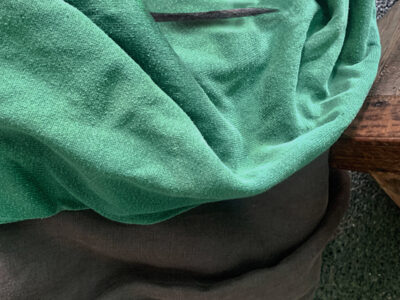Not An Allergen
NOVEL CORONAVIRUS (SARS-CoV-2)
Please note that this page is a summary of what we currently know about novel coronavirus, COVID-19, and skin concerns. As of the time of this writing, skin lesions were beginning to be described in COVID-19. Avoiding rashes and other skin problems from the irritants and contact allergens described below is important as they may be mistaken for the skin lesions of COVID-19. Because the virus is new and the understanding of it is evolving rapidly, this page may quickly become outdated. Refer to trusted sources such as the World Health Organization, Centers for Disease Control and Prevention, and your country’s department of health for up-to-date information about COVID-19.
Novel coronavirus caused a global pandemic, fear and uncertainty, economic instability, sickness, and death…but it is not a contact allergen. While it would never be on patch test trays, COVID-19 does teach us a few important things about how a pandemic can affect the skin and especially sensitive skins.
The virus is not dermatotropic (a virus that affects or is attracted to the skin) but its contagiousness has meant a necessary increase in more aggressive personal hygiene and disinfection, and an increase in contact with personal protective equipment (PPEs). Many people can suffer irritation and/or contact dermatitis due to the harm that alcohol, detergents and disinfectants can cause the hydro-lipid mantle of the skin. But it is health front liners who bear the brunt of skin issues. According to one study in Clinics and Dermatology, some of the skin concerns suffered by healthcare workers include “Pressure injury, contact dermatitis, itch, pressure urticaria, and exacerbation of pre-existing skin diseases, including seborrheic dermatitis and acne.” The most common skin complications seen are contact reactions — redness, burning, itching, barrier problems, scaling, and more — from the extended wear of PPEs:
- Extended wear of gloves can lead to redness and other reactions due to contact dermatitis (especially to rubber or latex gloves) or the sustained exposure to the sweaty environment that the occlusion creates (the gloves create a sealed environment).
- Hand washing is a concern for everyone but more so for front liners who wash their hands well over ten times a day.
- Extended wear of goggles and masks in particular (especially with the heat and sweat of exertion and stress) can cause swelling, burning, itching, urticaria, contact dermatitis, and even acne.
- Head covers and other occlusive equipment can trigger flare-ups of seborrheic dermatitis, folliculitis, and itching.
- Heat and sweat can cause pressure urticaria. This is not an allergy but a form of physical urticaria.
Dermatologists may need to care for people hoping to prevent infection as well as health front liners who may develop skin complications due to their efforts to stay safe and care for others. Some possible ways to prevent or alleviate symptoms could be to prioritize allergen-free, irritant-free, and non-comedogenic products.
Cleanser:
Hair and body washes like Superwash have the added benefit of cleansing hands, hair, scalp, and body both gently (allergen-free) and thoroughly (contains acceptable concentrations of coconut-derived SLS, which is antimicrobial).
Facial Cleanser:
Now is the time for the gentlest options to offset the friction, occlusion, and allergen-exposure from prolonged use of PPEs.
- For very red, dry, irritated skin, we suggest Red Better Deeply Soothing Cleansing Cream or Moisture Rich Creammmy Cleansing Milk.
- Otherwise, choose from among our allergen-free cleansers and scrubs.
- If skin is extremely sensitive, try cleansing with just 100% pure organic virgin coconut oil Know-It-Oil (keep it in the refrigerator for an anti-inflammatory cold compress at the end of the day).
- VCO can also be applied into the nostrils for additional comfort and protection.
Moisturizer and Barrier-Protection for Hands:
Apply emollients and barrier protective creams liberally onto hands following hand washing and before wearing PPE equipment.
- A good option is Know-It-Oil, or Oil’s Well (virgin coconut oil plus monolaurin). Both virgin coconut oil and monolaurin have multiple clinical studies showing their efficacy as antimicrobials, including as antivirals with an efficacy comparable to 80% alcohol. Make sure to rub the VCO well under and into the nails as well.
- Other moisturizers with VCO and monolaurin include Essence Hand + Body Smoother, Mommycoddling All-Over Lotion, and Creammmy Rich Intensive Moisture Milk.
- For even more barrier protection, follow the oil or moisturizer with a zinc oxide and titanium dioxide cream like Armada Baby, Armada Post-Procedure Barrier Cream, or Stay On Point! Skin Base Layer.
Skin Calmers:
The Big, Brave Boo-Boo Balm and Red Better Calm-The-Heck-Down Balm provide non-steroidal quick relief and non-irritating disinfection for itching, redness, and lacerations. While steroids may occasionally be necessary, they are contact allergens and prolonged steroid use can worsen the skin and cause other health issues.
Disinfection Techniques with Moisturizing, Film-forming, Barrier-Protective Alternatives:
See another disinfection technique using the products listed above. Based on a review of clinical studies on virgin coconut oil and monolaurin as effective antivirals, antibacterials and antifungals, this technique could give damaged skin some relief and time to heal.
Other Skin Concerns:
Dermatology patients with auto-immune skin disorders with chronic inflammation such as psoriasis, lupus, atopic dermatitis, etc. may also require additional care. Many of these conditions are treated with biologicals which are immune suppressive. Check with your dermatologist on the latest recommendations regarding whether the administration of these biologics needs to be delayed.
It is important to emphasize that, to our knowledge as of this writing, monolaurin has not been tested on SARS-CoV-2 specifically (neither has alcohol). This information is compelling but needs validation on this particular virus. The available evidence seems to suggest similar efficacy to alcohol in destroying enveloped viruses and some coronaviruses. Follow your doctor’s instructions, and rely on trusted sources such as the World Health Organization, Centers for Disease Control and Prevention, and your country’s department of health. For a study review of VCO, monolaurin and other coconut oil derivatives as antivirals, antibacterials and antifungals, click here.
If you have a history of sensitive skin, don’t guess: random trial and error can cause more damage. Ask your dermatologist about a patch test.
To shop our selection of hypoallergenic products, visit vmvhypoallergenics.com. Need help? Ask us in the comments section below, or for more privacy (such as when asking us to customize recommendations for you based on your patch test results) contact us by email, or drop us a private message on Facebook.
For more:
On the prevalence of skin allergies, see Skin Allergies Are More Common Than Ever and One In Four Is Allergic to Common Skin Care And Cosmetic Ingredients.
To learn more about the VH-Rating System and hypoallergenicity, click here.
Main References:
Regularly published reports on the most common allergens by the North American Contact Dermatitis Group and European Surveillance System on Contact Allergies (based on over 28,000 patch test results, combined), plus other studies. Remember, we are all individuals — just because an ingredient is not on the most common allergen lists does not mean you cannot be sensitive to it, or that it will not become an allergen. These references, being based on so many patch test results, are a good basis but it is always best to get a patch test yourself.
2. W Uter et al. The European Baseline Series in 10 European Countries, 2005/2006–Results of the European Surveillance System on Contact Allergies (ESSCA). Contact Dermatitis 61 (1), 31-38.7 2009.
3. Wetter, DA et al. Results of patch testing to personal care product allergens in a standard series and a supplemental cosmetic series: An analysis of 945 patients from the Mayo Clinic Contact Dermatitis Group, 2000-2007. J Am Acad Dermatol. 2010 Nov;63(5):789-98.
4. Verallo-Rowell VM. The validated hypoallergenic cosmetics rating system: its 30-year evolution and effect on the prevalence of cosmetic reactions. Dermatitis 2011 Apr; 22(2):80-97.
5. Ruby Pawankar et al. World Health Organization. White Book on Allergy 2011-2012 Executive Summary.
6. Misery L et al. Sensitive skin in the American population: prevalence, clinical data, and role of the dermatologist. Int J Dermatol. 2011 Aug;50(8):961-7.
7. Warshaw EM1, Maibach HI, Taylor JS, Sasseville D, DeKoven JG, Zirwas MJ, Fransway AF, Mathias CG, Zug KA, DeLeo VA, Fowler JF Jr, Marks JG, Pratt MD, Storrs FJ, Belsito DV. North American contact dermatitis group patch test results: 2011-2012.Dermatitis. 2015 Jan-Feb;26(1):49-59.
8. Warshaw, E et al. Allergic patch test reactions associated with cosmetics: Retrospective analysis of cross-sectional data from the North American Contact Dermatitis Group, 2001-2004. J AmAcadDermatol 2009;60:23-38.
9. Foliaki S et al. Antibiotic use in infancy and symptoms of asthma, rhinoconjunctivitis, and eczema in children 6 and 7 years old: International Study of Asthma and Allergies in Childhood Phase III. J Allergy Clin Immunol. 2009 Nov;124(5):982-9.
10. Kei EF et al. Role of the gut microbiota in defining human health. Expert Rev Anti Infect Ther. 2010 Apr; 8(4): 435–454.
11. Thavagnanam S et al. A meta-analysis of the association between Caesarean section and childhood asthma. Clin Exp Allergy. 2008;38(4):629–633.
12. Marks JG, Belsito DV, DeLeo VA, et al. North American Contact Dermatitis Group patch-test results, 1998 to 2000. Am J Contact Dermat. 2003;14(2):59-62.
13. Warshaw EM, Belsito DV, Taylor JS, et al. North American Contact Dermatitis Group patch test results: 2009 to 2010. Dermatitis. 2013;24(2):50-99.
14. Bogdanov I, Darlenski R, Hristakieva E, Manuelyan K. The rash that presents as a vesiculobullous eruption. Clin Dermatol. 2020;38(1):19–34. doi:10.1016/j.clindermatol.2019.10.012.
15. Darlenski R, Tsankov, N. Covid-19 pandemic and the skin – What should dermatologists know? Clin Dermatol. 2020 Mar 24. doi: 10.1016/j.clindermatol.2020.03.012 [Epub ahead of print]
Want more great information on contact dermatitis? Check out the American Contact Dermatitis Society, Dermnet New Zealand, and your country’s contact dermatitis association.
 Laura is our “dew”-good CEO at VMV Hypoallergenics and eldest daughter of VMV’s founding dermatologist-dermatopathologist. She has two children, Madison and Gavin, and works at VMV with her sister CC and husband Juan Pablo (Madison and Gavin frequently volunteer their “usage testing” services). In addition to saving the world’s skin, Laura is passionate about health, inclusion, cultural theory, human rights, happiness, and spreading goodness (like a great cream!)
Laura is our “dew”-good CEO at VMV Hypoallergenics and eldest daughter of VMV’s founding dermatologist-dermatopathologist. She has two children, Madison and Gavin, and works at VMV with her sister CC and husband Juan Pablo (Madison and Gavin frequently volunteer their “usage testing” services). In addition to saving the world’s skin, Laura is passionate about health, inclusion, cultural theory, human rights, happiness, and spreading goodness (like a great cream!)

